Innovation projects guided by SAP Activate implement S/4HANA Cloud solutions with intelligent business processes based on modern cloud architectures and technologies.
SAP Activate offers transformation roadmaps to empower S/4HANA GROW or RISE innovation packages with agile project methodologies, best practices and tools.

All of these implementation roadmaps follow clean core strategies based on key principles and best practices.
SAP Activate agile project management workstreams lead S/4HANA Public or Private Cloud projects with iterative implementations, defined phases and deliverables. Available Best Practices content shortens time to value, reduces the implementation risks with predictable results and enables S/4HANA Cloud projects to start with running systems.
Based on standardized content, customers scope their solutions within Fit-to-Standard workshops and realize implementation tasks with guided configurations. The agile project methodology, combined with standardized content and emerging cloud technologies, enables fast innovation cycles.
SAP Activate offers Innovation Roadmaps to GROW with SAP S/4HANA on public cloud or RISE with SAP on private cloud. These roadmaps are structured in phases of project stages separated by quality gates with defined deliverables. Deliverables combine tasks with work to be performed for input and output artifacts like documents or information.
SAP Activate innovation roadmaps offer navigation options between phases, workstreams and content. Workstreams are teams grouped by activity type, with collections of deliverables as outcomes.
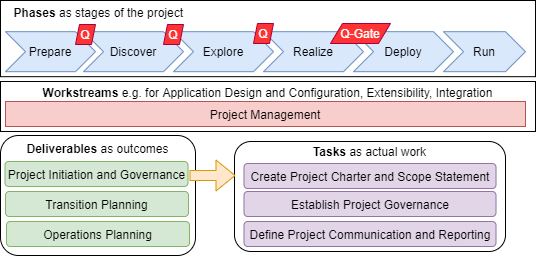
SAP Activate roadmaps provide accelerators as templates, guides, preconfigured content or test scripts to facilitate the implementation of project deliverables.
The SAP Process Navigator visualizes pre-defined business processes as scope items for S/4HANA Cloud transformations with GROW or RISE SAP packages. Activated scope items enable business processes for S/4HANA LoBs (Line of Business) which are divided into business areas with specific scope items.
Best practices content for S/4HANA 3SL Public Cloud Editions is included in each release and can be activated via Central Business Configuration. For New Implementations with RISE, S/4HANA [Best Practices](#rise-s4hana-cloud-pce-business-content “RISE S/4HANA Cloud PCE Business Content“) activation is available with the Solution Builder in development systems.
Scope items are delivered with additional information like fact sheets which describe benefits and steps of business processes, editable BPMN2 process flow presentations, setup instructions and test scripts. Building blocks of SAP Activate Best Practices Content are self-contained and reusable with configuration sets as groups of IMG activities, configuration guides or unit tests. Scope items and building blocks are associated with cardinality n:n.
Additionally, SAP Best Practices offer content for migrations and integrations. Migration content is available for non-SAP and SAP databases, with data validation rules and quality content to address poor quality or duplicated entries.
The API Business Accelerator Hub offers integration content for categories like APIs, Events or Business Processes. Pre-packed content can be implemented out of the box with SAP Cloud Integration and Cloud Integration Automation Service (CIAS). Both integration tools are deployed on SAP BTP, CIAS is accessible via SAP for Me, Maintenance Planner and SAP Cloud ALM.
The SAP Activate innovation bundle decision for S/4HANA Cloud is a multi-step process which starts with a Digital Discovery Assessment proposal which needs to be qualified with a SAP Brand Guardian review.
The decision between GROW and RISE with SAP includes the automated Digital Discovery Assessment (DDA) proposal, followed by an individual review and the selection of an innovation bundle with base or premium characteristics.

Some customer specific decision criterias are highlighted in the comparison below.

SAP offers GROW & RISE contracts with bundles of services from different areas like Software & Support, Infrastructure Management, Technical Managed Services in one contract. Contract details of these innovation bundles are specified with Descriptions and Supplements of the cloud services.
The Roles and Responsibilities document of RISE contracts describes shared responsibilities between SAP, customers and partners for the catalog of standard and additional services. Furthermore, RISE offers a tailored option to combine custom Full User Equivalents with individual infrastructure resources.
Part of GROW and RISE with SAP bundles are starter packages for the SAP Business Technology Platform (SAP BTP) with Cloud Platform Enterprise Agreement (CPEA) credits, selected SAP Signavio Business Process Transformation services or optional digital Business Network collaboration. These innovation bundles enable modern User Experience (UX) with Enterprise Automation, Business AI and Embedded Analytics capabilities.
SAP Activate Roadmaps for GROW and RISE with SAP offer common activities, but also implementation specific tasks. The diagram below visualizes some common and specific key activities of both roadmaps.
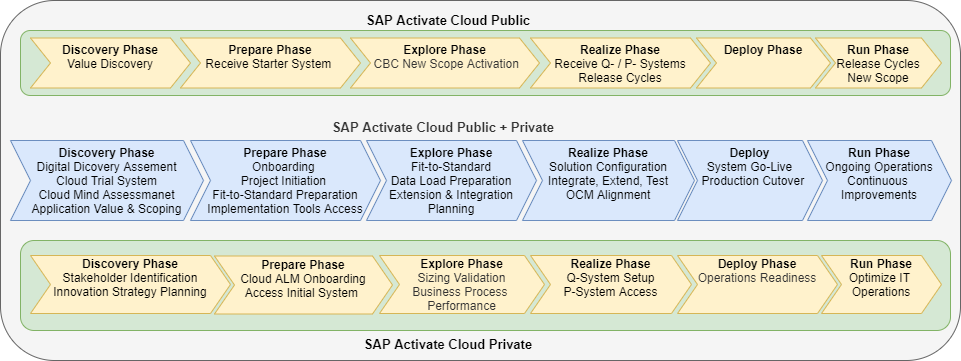
SAP Activate Project leads are responsible to create projects in SAP Cloud ALM for implementation to manage process scope imported from Digital Discovery Assessment results, selected via SAP Activate Roadmap scenarios or created manually. Project tasks are generic project activities generated from SAP Activate roadmaps or manually.
During Fit-to-Standard workshops LoB experts assign configuration requirements to CALM processes. The SAP Cloud ALM requirements app offers a masterist of all requirements.
Some differences between New Implementation and System Conversion transition approaches are shown in the diagram below. These differences are mainly located in areas like custom value discovery, custom code handling, system setup, data migration and process design.
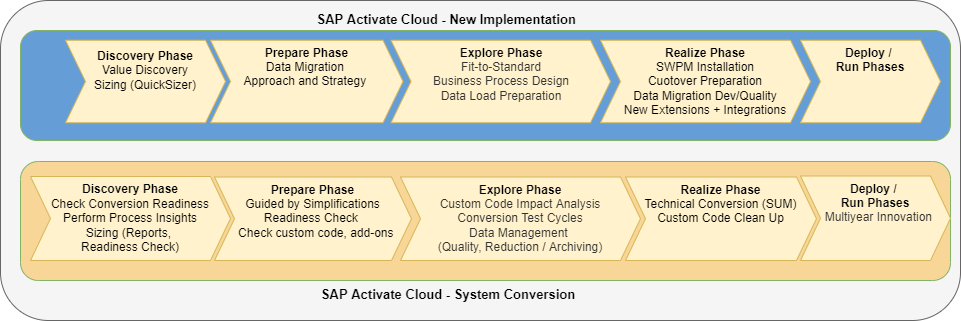
Scope Activation GROW CBC RISE Solution Builder New Implementations
Customer executive sponsors are responsible to define a high-level business transformation strategy plan for their business case. Together with sales persons, they complete the Digital Discovery Assessment to find the innovation bundle and deployment option which fits best to their requirements.
Furthermore, the established project team starts the S/4HANA value proposition based on SAP Best Practices Business Processes with end-to-end process insights with SAP Signavio Business Process Intelligence.
The Digital Discovery Assessment (DDA) proposes the S/4HANA Cloud deployment option and innovation bundle for SAP Activate GROW & RISE transformation projects.
DDA Outcomes are
S/4HANA Two-Tier Scenarios
S/4HANA Two-Tier Deployment scenarios implement two layer ERP systems with end-to-end solutions across hybrid system landscapes.
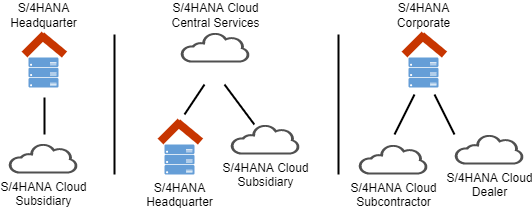
One layer implements a standardized system and the second system layer enables innovate, flexible business functions as cloud solutions. Two-tier deployments increase the complexity of IT architectures with additional integration requirements like harmonized master data and configuration management between systems.
Examples of two-tier ERP scenarios are Headquarter - Subsidiary scenarios on different environments, central services for line of business spin-offs and legal entities as cloud solutions or Ecosystem models with subcontractor or dealer cloud systems.
S/4HANA Cloud Characteristics
SAP S/4HANA Cloud Core Administrative ERP tasks are covered by the Line-of-Business (LoB) solutions Finance, Procurement and Sales within end-to-end processes Procure to pay, Order to cash and Record to report. Additionally, service centric industries offer Professional Services LoB for consulting services and Services LoB for technical services. LoBs in product centric industries are R&D Engineering, Manufacturing, Asset Management and Supply Chain.
GROW & RISE with SAP cloud bundles have some common characteristics defined by single contracts with SAP. Technical managed services for SaaS, PaaS and IaaS cloud components are managed by SAP with single SLAs.
For RISE with SAP contracts, some responsibilities are flexible like Application Management Services (AMS) services which can be taken over by Partner or SAP Cloud Application Services (SAP CAS).
SAP offer landscapes with 3 systems (3SL) with different release cycles and frequencies of twice a year for GROW with SAP and two-year for RISE with SAP. S/4HANA Public Cloud doesn't allow Add-ons, in contrast to Private Cloud environments, where solution extensions or certified add-ons are allowed and third party Add-ons can be managed by customers with restrictions.
Some important differences between S/4HANA Public and Private solutions have to be considered to realize configurations and extensions. Public cloud environments offer guided self-service configuration user interfaces (SSCUI), restrict extensibility options and prevent modifications. In contrast to S/4HANA Private Cloud where configuration options are available in the Implementation Guide (IMG).
System Conversions
RISE with SAP Activate projects prefer System Conversion to S/4HANA as recommended transition option, when the implemented business processes mostly fit to the long-term strategy and can be taken over for reuse. Listed Simplification items guide SAP Activate System Conversions in incremental innovation projects.
The project duration of S/4HANA System Conversions is mainly affected by technical factors like data size and custom code quality. From functional perspective, the number of company codes, ledgers amd operating concerns affect the project duration.
As preparation activities, the target S/4HANA compatibility of components, custom code and add-ons has to be checked. Big Bang System Conversions of application and database enable to migrate and retain existing configuration, custom code and historical application data in one step.
Selective Data Transition
The SAP Activate S/4HANA Selective Data Transition option is recommended if current processes should be retained with selective adjustments. This selective approach allows customers to go live in phases e.g. with selected business units or countries.
Additionally, the selective approach allows to merge multiple ERP systems into one or to split SAP systems with carve outs of business units.
Landscape Transformation Tools help to tailor the scope between System Conversion and New Implementation or to reduce the transformation effort with reduced old data and application areas.
New Implementation / Greenfield
New Implementations of S/4HANA are offered as transition option for RISE with SAP Private Cloud systems and are the only option for GROW with SAP Public Cloud developments.
S/4HANA New Implementations enable customers to reimagine and design new business processes with SAP Activate Best Practices.
Transactional and master data can be migrated with predefined migration objects of the SAP S/4HANA Migration Cockpit. The number, volume and complexity of the initial data load mainly affects the project duration.
One important SAP Activate task in S/4HANA Cloud projects projects is the preparation of Fit-to-Standard workshops driven by the Application Design & Configuration and Technical Architecture & Infrastructure workstreams.
Part of the workshop preparation are to gather Level 2 information for the Business Driven Configuration Questionnaire (BDCQ) assessment and the creation of initial integration API lists.
Fit-to-Standard workshops for public cloud GROW with SAP projects can be performed in Starter systems with activated SAP Activate Best Practices content.
For private cloud or on-premise S/4HANA implementations, there are different approaches available to prepare Fit-to-Standard workshops like setting up a Best Practices client in Sandbox (SBX) or Development systems, with the option to copy Sandbox systems for the Realize phases. This approach can reduce the effort to deploy additional systems for New Implementations.
Some further preparation activities are to review documentation (e.g. SLA agreement, Cloud Mindset implementation, SAP Cloud ALM), to enable system access (e.g. Learning Hub, SAP Cloud ALM for Implementation), the introduction of Organizational Change Management (OCM) and to enable Project Management.
S/4HANA Enterprise Management Layer
The SAP Enterprise Management Layer (EML) is based on SAP Activate Best Practices and can be used to prepare a Fit-to-Standard system for on-premise or private cloud S/4HANA implementations.
As part of the SAP Cloud Appliance Library, the EML service offering can be deployed for RISE with SAP on demand with additional costs.
The EML supports S/4HANA projects for Multinational Corporations with complex accounting and reporting requirements with preconfigured SAP Activate Best Practices scope items.
The SAP Activate Project Management workstream ensures that the project requirements can be realized with planning activities, scheduling tasks and tracking of time, budget, scope, quality.
SAP Activate projects teams can be grouped on different key stakeholder levels into core team and executive sponsors, key users and extended project team, internal or external consumers and implementation project team.

Members of this stakeholder groups have specific roles and responsibilities like Business Process Experts of the Core project team which have to drive business decisions, perform testing and confirm configuration.
Some tasks of Configuration Experts and implementation partner consultants are to analyze Fit-to-Standard processes and to resolve business process issues. Users for Lead and LoB configuration experts shall be created with administrator authorization.
Technical experts for integration, customization or migration tasks extend the core implementation team to join Fit-to-Standard workshops. Key users validate or test new business processes and share knowledge with their peers as part of the extended project team.
Organizational Change Management
The SAP Organizational Change Management (OCM) for GROW and RISE with SAP Cloud Projects is fully aligned with the SAP Activate Methodology. OCM for SAP S/4HANA Cloud projects shall prepare for associated changes and help to develop an innovation culture.
Some OCM tasks are the identification and engagement of stakeholders, to define a communication plan with defined channels to get a common understanding, define an organizational transition and adaption path, enable team learning with appropriate content.
OCM effectiveness can be enhanced by gathering information from project members, organizing workshops for employees to check the progress of change and collect usability feedback from end users.
OCM can work closely together with Customer Center of Expertise (CoE) which aligns IT and LoBs as collaboration hub.
SAP Cloud ALM (CALM) enables implementation projects for GROW with SAP or RISE with SAP Public or Private Cloud solutions to manage application lifecycles with Design, Build, Test and Deploy phases. Project Managers set up SAP Activate implementation projects in CALM and assign time boxes of releases and system group collections to deployment plans.
CALM implementation generates actionable tasks for SAP Activate content-driven Scoping and Realization of cloud projects with Best Practices. CALM projects are containers for project scope, requirements, test cases, tasks and user stories.
CALM tasklists for SAP Activate S/4HANA Cloud project are hierarchically organized with phases, workstreams and tasks assigned to teams, roles and persons. Tasks can be created for requirements collected in Fit-to-Standard workshops or manually for specific business processes.
SAP CALM is integrated with SAP Cloud Transport Management Service (TMS) to orchestrate transport requests. Beyond that, the SAP CALM Test Management offers agile process and requirement oriented test cases based on business scope for manual and automated tests. Test automates can not be removed from tests plans after first executions or in case of existing data bindings to other test automates.
SAP recommends 5 Golden Rules for S/4HANA Public or Private Cloud Transformation projects and GROW & RISE with SAP packages include cloud services to implement the clean core. Coud principles foster continuous innovations with integrations or extensions based on modern cloud technologies.
Clean core implementations, based on SAP Activate Best Practices, shall be realized with pre-configured solutions and predefined processes. Non-cloud like deviations from standard have to be documented transparent.
SAP Activate implements GROW & RISE with S/4HANA suite qualities as target characteristics.
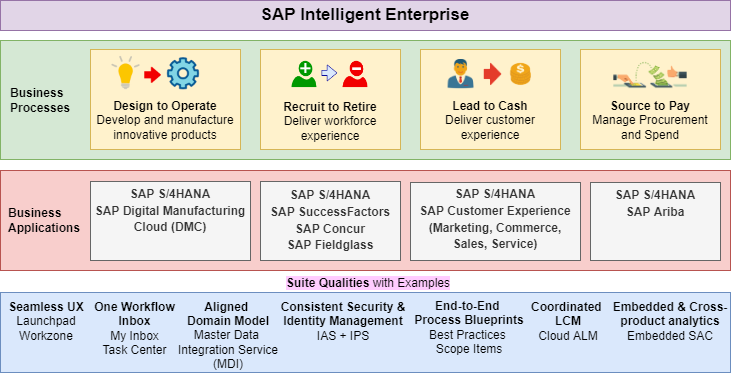
S/4HANA Suite qualities define One Domain Model for business objects across applications, implementable end-to-end process blueprints, seamless user experience, one workflow inbox as task center, consistent security and identity management, coordinated lifecycle management with Cloud ALM,embedded and cross-product analytics.
These suite qualities reflect priorities of SAP customers and empower GROW & RISE S/4HANA Cloud implementations.
One of the most important activities in the SAP Activate Explore phase is the validation of predefined processes in Fit-to-Standard workshops. Some workshop outcomes are Backlog templates and Business Driven Configuration Questionnaires (BDCQ) assessments with gathered Level 3 information with detailed information for business decisions, designs and configuration.
Backlog template accelerators capture Delta Requirements and Gaps during Fit-to-Standard workshops to plan sprints and releases.
SAP Activate Project Management workstreams introduce risk management and reporting to control the project progress and performance.
Organisational Change Management (OCM) starts with analysis and planning activities. Some OCM measures are to set up change agent networks with selected group of business representatives, provide stakeholder specific information and to enable access to key or end user training.
Ready-to-use business content, like SAP Activate Best Practices with accelerators, enables S/4HANA transformations with fast time to value and predictable results. In A/4HANA New Implementation projects, the available Best Practices content should cover most of the customer requirements.
Private Cloud Business Content
In RISE with SAP Private Cloud implementations one activation request for Best Practices with Solution Builder transaction /SMB/BBI is included in the contract and documented with SAP Note 3039705.
SAP Activate Best Practices activation has to be prepared with the creation of a best practice client and the download of the most recent best practices content. SAP Activate Best Practices should only be used for greenfield implementations and cannot be activated in already configured clients.
SAP Activate S/4HANA Public or Private Cloud projects are realized with iterations of scoping, configuration and implementations. This agile approach includes incremental builds of solution configuration, extension development and integration setup. The resulting deployable increments have to be tested with a sequence of implementation, integration and end-user acceptance tests before they can be deployed to production environments.
Some characteristics of GROW with SAP A/4HANA Public Cloud New Implementations are standardization, fully mobilization and scalability.
The SAP Central Business Configuration (CBC) tool offers guidance and assistance to adapt SAP Best Practices content with evaluation and implementation projects. CBC projects are structured into lifecycle phases with specific activities and milestones.
S/4HANA Public Cloud expert configuration has to be requested by SAP to make changes to standard available configurations of existing business processes or to build business processes that are specific to custom business needs.

Some activities like setting up business roles and integrations, assigning permissions or migrating data have to be done directly in productive systems without guided CBC .
SAP Activate Design and Configuration Workstreams have to define the test strategy for Business Process testing in the Explore phase. This test strategy defines different test types for the Realization, Deploy and Run phases for S/4HANA implementations, extensions and upgrades.
Unit Tests test single piece of functionality as part of the realization. String tests combine multiple unit tests.
Implementation Tests are performed by configuration experts to test the correctness of configured business processes in realize phases.
Integration testing validates the functional correctness and data integrity across end-to-end processes as part of the realize phase.
End User Acceptance tests check day-to-day business scenarios at the end of the realize phase to confirm gaps are closed.
Regression tests confirm that new functionality of upgrades do not cause defects in existing functionality in Run and Operate phases.
Public Cloud Test Tools
SAP S/4HANA Public Cloud offers Fiori Apps for test processing and automation. The Manage Your Test Processes Fiori App leverages pre-delivered standard test processes, offers the option to create custom test processes from scratch or as copy of a standard test process and to allow SAP to execute Post Upgrade Tests (PUT).
Test plans with test processes and test variants can be created with the Test Your Processes app. The app
Results after post-upgrade or customer tests can be reviewed with the Analyze Automated Test with status tests or processes and the option to drill-down to process step details.
Solution Manager Test Suite
SAP Solution Manager Solution Test plans are sets of test cases defined for solution, branch and scope. Test configurations contain system data container, test data container and test scripts which describe the sequence of activities that are to be tested for specific components.
In SAP Activate Deploy phases runnable increments are continuously deployed to production systems.
Some activities in SAP Activate Run phases are ongoing system operations, continuous adaptions and regression testing after upgrades applied to quality system.
S/4HANA Public Cloud Activate Deploy phases are only available CBC implementation project. Some post go-live activities customers have to perform in SAP S/4HANA Public Cloud systems are regression testing of business processes, new scope activation and maintaining business catalogs.